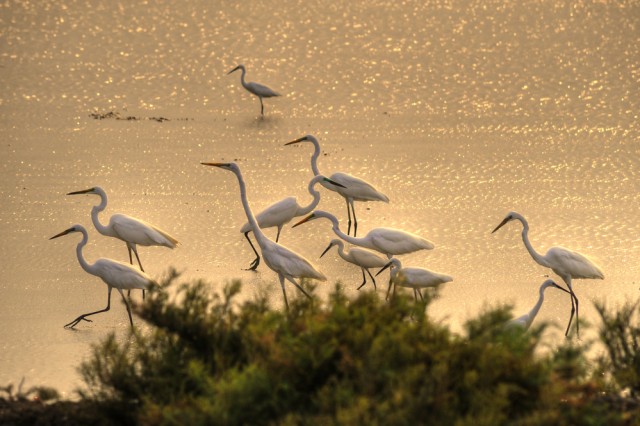Great Egret
Status
Great egret (Ardea alba) has no formal listing status, but its rookeries (nesting colonies) are considered sensitive by the California Department of Fish and Game. This species is a common yearlong resident throughout much of California, except for in higher elevations and deserts. In Northern California, great egret is fairly common year round in coastal lowlands, inland valleys, and in the Central Valley. Over a century ago, this species was nearly eliminated in North America because adults were destroyed for their feathers and plumes. However, public opinion and conservation legislation resulted in a significant rebound in the great egret population.
Description
Great egret is a medium-large sized white heron with a long, slender neck. This species has a short tail, dagger-like yellow-orange bill, and long black legs. During the breeding season, they develop ornamental plumes from their throat and rump and the color of their face and leg skin intensifies. During flight, the head of the great egret is held back over the folded neck. Adult great egrets range in size from 37 to 41 inches in length and have a wingspan of 51 inches.
Habitat Requirements
Great egret occurs in association with fresh and saltwater wetlands, estuaries, lakes, slow-moving streams, mudflats, salt ponds, irrigated croplands, and pastures. This species roosts and nests communally in dense stands of large trees, usually near water. Nests are built in tall trees often 20 to 40 feet above ground, and consist of a large, flat platform of sticks and stems of marsh plants. The nest is generally 48 inches in diameter, but can be bulkier in size as it is re-used seasonally and nesting material is added. Nesting of great egrets typically occurs from March to July, during which time most populations are concentrated near nesting colonies. Usually 3 to 5 pale, bluish green eggs are laid and incubated for 26 days. The downy young are fed by both parents and first fly at about 5 to 6 weeks.
Great egrets feed in shallow water, along shorelines, and in grassy areas where they stalk slowly or stand motionless and wait for prey to appear within striking range. They mainly eat fish, amphibians, snakes, snails, crustaceans, insects and small mammals.
Local Occurrence
Great egrets occur at a number of WHF preserves, especially those with or adjacent to wetlands.

 (916) 434-2759
(916) 434-2759



